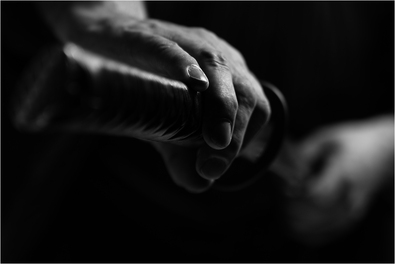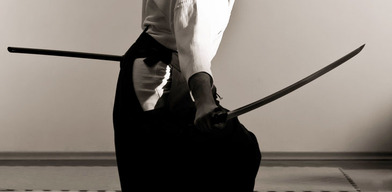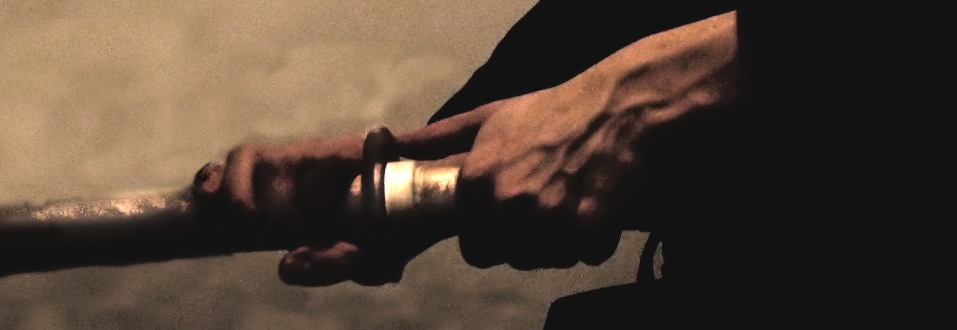 Four years ago this June, I was standing in a watermelon patch beside Himeji's Semba River shooting the breeze with my longtime friend and regular contributor of wisdom to this blog, Smokin’ Joe Matsumoto, the kitchen gardener who lives up my street. A crescent moon hung in the eastern sky. Bats skimmed the Semba for midge flies and a Buddhist temple bell bonged somewhere off. “You look stressed,” Smokin’ said. “It’s these new Uniqlo underpants. They’re cooking my eggs,” I said. “No, mentally. I mean you look wrapped too tight.” “Where did you learn that expression?” “From my English teacher.” “I’m an English teacher!” “You’re expensive.” “Life’s expensive. It’s gettin on top of me.” “You should get a grip.” (fishing a cigarette from his pocket) “Get a grip?” “Learn a martial art.” “Like what?” “Like iaido.” “Like what?” “The art of swordsmanship.” “So, next time an *Uomachi goon with “T U F F L O V E” tattooed on his knuckles hauls me out of a club at dawn I can shout, “Unhand me chimp or I’ll dice you like dog meat with the sword I don’t have on me right now.” “Sometimes I have no idea what you’re talking about. (lighting the cigarette) There’s an old samurai saying, “Win the battle without drawing the sword.” (exhaling) Iaido teaches you to be aware of your enemy, to anticipate his next move and to meditate on your own. But most of all it teaches you that to use your sword is the very last option.” The bats flitted overhead. The Semba raced on toward the Inland Sea; everyone and everything in a hurry except old smokestack and his watermelons. I left him to his beans, melons and samurai philosophies and followed the river back to the empty streets and emptier houses of the Good Hood, my home away from Australia for 15 years. Seven days later. Twilight and the city Shinto shrine was closing for business. Two blocks south the dojo of Kanshou-ryu (the Flying Crown sword style) was opening for business. I stepped beneath its flickering entrance light, removed my shoes and entered a small wooden hall. Scuffed and scarred floorboards rubbed against my feet. Odors of oiled steel, old sweat and mosquito coil filled my nostrils; there was tobacco smoke, too. I crossed the floor, passing racks of swords, lances and spears, to where a small woman stood in the corner. A coal black ponytail fountained off her head and her hands rested on her hips. A cigarette smoldered between her lips. She wasn’t waiting, she was expecting.  “Enter this dojo with the mind in which you left it,” Souke said. I was about to say I hadn’t had a chance to leave it. Her manicured finger silenced me. It hoisted my gaze to four dark, swirling pictograms on the wall overhead which she read for emphasis, “Sho shin kan tetsu." She took a long draw of the cigarette and exhaled. “Matsumoto-san and I went to the same highschool. He told me you were coming.” Highschool? Souke (the Grandmaster) and Smokin’ Joe? Peas in a pod. Now I understood - the samurai philosophies... She studied my height and walked to a wall rack. She took down something long, cold and heavy. “This is not for beginners," she said, “But it’ll do for you." Compliment or caveat? I couldn’t tell. Nevertheless on that humid June night four years ago, my second life began. Names like Spring Lightning, Moon Sleeve, Wind God, The Secret, Valley Wind, Blizzard, Spinning top, Slicing the Swallow, Ocean Current and Leaping Frog - cutting techniques - became part of my Tuesday and Friday night lexicon. Two nights a week, every week for a year, every year for four years, off came the grimy business collar, on came the dogi and hakama. By night’s end, each held a day’s worth of sweat and 206 weary bones. There are three distinctive sounds in an iadio dojo: the click! (of a sword being freed from its scabbard), the vicious whistle (of a blade carving through air) and the soft whoosh (of blood being ridden from the blade). Not real blood, but something symbolic of blood. Stress. Iaido is the ‘art of drawing the sword.’ It has also been called “Moving Zen” which I guess implies the ability to perform a highly disciplined action with an uncluttered or ‘empty’ mind. In other words the last thing you should be thinking of when handling a ‘live’ sword, or shinken, is how much blood is going to leak from your body if you make a mistake. “Let your sword do the work, let it fly,” Souke told me on my first night. “Let it fly, but remember that control is everything.” Words to live life by. Next week: Moving Zen part II *Uomachi is the name of Himeji's ‘entertainment’ street. It is generally referred to as a precinct and is home to some 3000 bars, clubs and lounges.
0 Comments
Leave a Reply. |
This Blog:What is the essence of a traditional Japanese neighbourhood? Writing from my home in Himeji, a castle town in western Honshu, Seaweed Salad Days distills, ferments, presents! Archives
March 2024
Categories
All
|

 RSS Feed
RSS Feed
